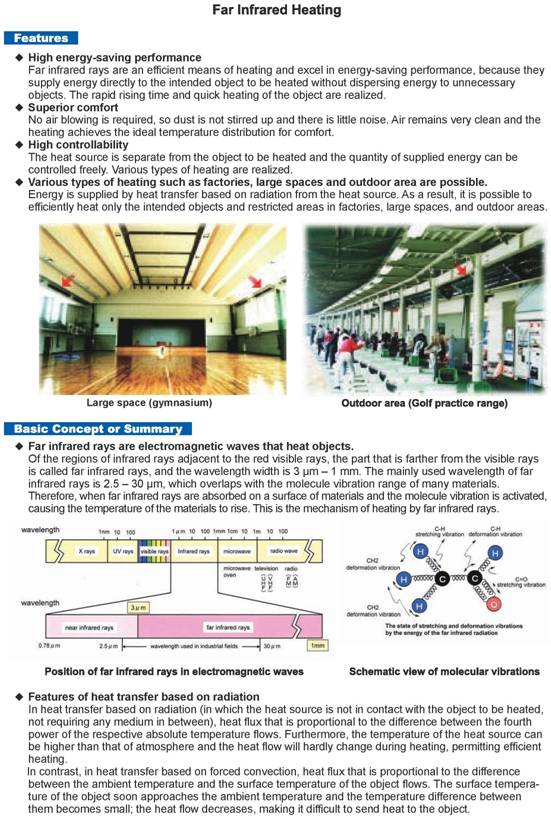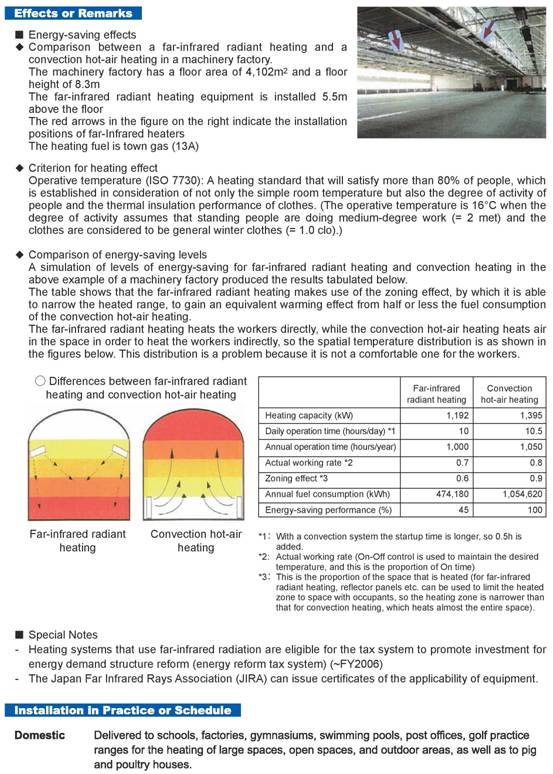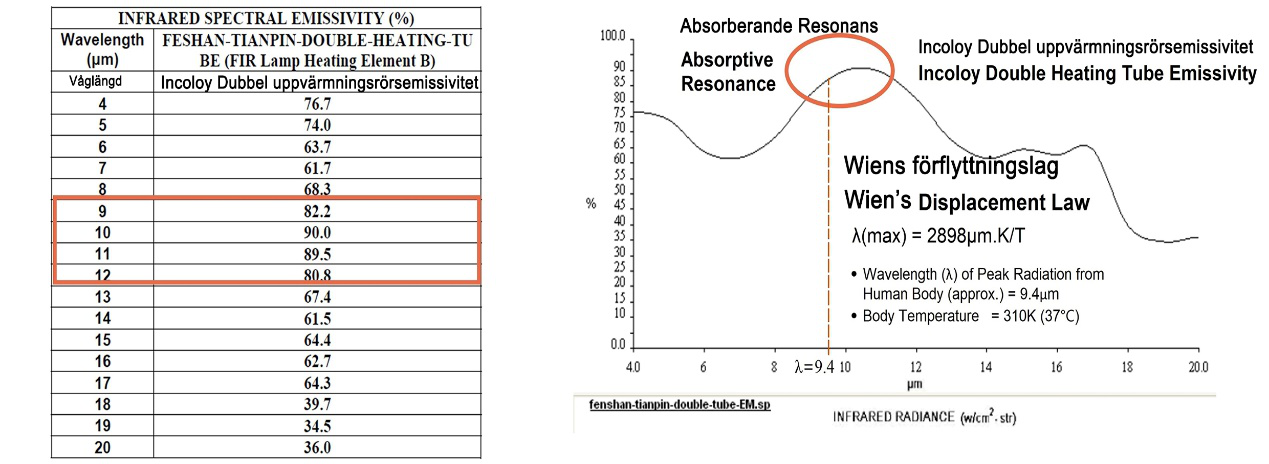Frequently Asked Questions
Please click on one of
the links below that best describes your product question
:-
2.
Is Infrared Radiant Heating safe?
3.
Is Infrared Radiant Heating beneficial to
us?
5.
How can Infrared Radiant Heating save energy?
6.
Are your 360° Electric Infrared Radiant Heaters durable and safe?
8.
What is Polycyclic Aromatic Hydrocarbons (PAHs)?
10.
How do PAHs enter the human body
11.
Effect of Natural Gas on People with Environmental and Chemical
Sensitivities
12.
Benefits of infrared absorptive resonance on human body?
(1) What is Infrared Heating?
Infrared heat is an invisible radiated form of energy within the electromagnetic
spectrum (of which visible light forms part) that directly transfers heat
to people or objects in its path through a process called conversion,
without heating up the surrounding air. Not unlike visible light,
infrared energy travels in a straight line and at the speed of light.
Convectional methods of heat transfer warm up the air surrounding the
people or objects and rely on the circulation of warmed air to transfer
heat. Infrared radiation basically has nothing to do with either
ultraviolet radiation (which is actually near the other end of the spectrum
of visible light and gives you a sunburn and may harm your skin).
(2) Is Infrared Radiant Heating safe?
Our solar Sun is the principal source of radiant energy that
we receive on a daily basis since our birth.The Sun produces most of
its energy in the infrared segment of the
electromagnetic spectrum.
In an article entitled “Infrared
Thermal System for Whole-Body Regenerative Radiant Therapy”
by Dr. Aaron M. Flickstein, reported in the Wellness Letter, October 1990,
from the
(3) Is Infrared Radiant
Heating beneficial to us?
Our 360° Electric Infrared
Radiant Heaters are available in range of 1400W, 1900W and 2400W models.
People sitting under our Infrared Radiant Heaters will feel comfortably
approx. 10-15° Celsius warmer
(depending upon ambient conditions)
Far infrared rays have been shown to promote human blood circulation and
metabolism, removal of toxins and heavy metals from our bodies, alleviation
of tension, stress and pain, and efficacy in extremity wound healing.
(4) Energy Saving Features


(5) How can Infrared Radiant Heating save energy?
In open areas, entrances and exits, and especially in areas where draughts
disperse warm air, directionally focused infrared radiant heating can be
very effective.
Warm air is lighter than cold air. Conventional methods of heating firstly
warms the entire volume of air near the ceiling of a room and continues
until the temperature gradient reaches the floor of the room where people
work, irrespective of which portions of the room are occupied, and results
in significant waste of energy.
No other effective method of heating provides more efficient localized
heating than Infrared Radiant Heating. Generally speaking, localized
heating, as compared to central heating, saves energy and money. With
the recent rise in natural gas/oil prices, Electric Infrared Radiant Heater
may prove to be a timely and cost saving alternative to consumer needs for
comfort heating in homes, at play or in commercial settings.
(6) Are your 360° Electric Infrared Radiant Heaters
durable and safe?
Our 360° Electric
Infrared Radiant Heaters, which have been evaluated, tested, approved for
safety and certified with CE/GS/SAA/CB/CCC/ETL/cETL IPX4 Splash-proofed, are constructed with Aluminium/Zinc/Stainless
Steel Alloys fitted with Stainless Steel or Incoloy heating elements, and are shock/vibration resistant and durable.
Heating elements are warranted at 3,000 hours of normal use.
(7) What is the comparison between an Electric Infrared
Radiant Heater and a Natural Gas/Propane Radiant Heater?
Electric Infrared Radiant Heater
|
Gas Infrared Heater
|
|
|
Electric
powered
|
Gas-fired
mostly by natural gas or propane
|
No
storage of energy source required
|
Problem
with storage of dangerous fuel
|
Focus
of infrared irradiation with reflector
|
Normal
infrared irradiator
|
Clean
and efficient use of electricity with no gaseous discharge
|
Possibly
harmful gaseous or other discharges from burning fuel
|
Light
weight with wheeled-base for easy mobility
|
Heavy
weight with gas storage tank
|
No
replenishment required for energy source
|
Intermittent
replenishment of gaseous fuel required
|
Easy
15 min. Do-it-yourself assembly
|
Gas
piping installation by technician may be required
|
No
replacement electric wiring normally required
|
Periodic
replacement of gas hose for safety
|
Both
indoors and outdoors uses
|
Mostly
outdoors use; indoors use only with open air
|
Quick
warming
|
Slower
warming
|
(8) What is Polycyclic
Aromatic Hydrocarbons (PAHs)?
Polycyclic Aromatic Hydrocarbons (PAHs) are
chemical compounds consisting of fused aromatic rings, and are lipophilic in that PAHs are
relatively insoluble in water, but dissolve readily in fats and
oil. PAHs have rather low vapour pressure and are found in air, at ambient
temperature, both in the form of vapour and in
associated with particulate matter.
(9) How are PAHs produced?
PAHs are formed by incomplete combustion of
organic matter or carbon-containing fuels. Different types or
manners of combustion yield different distributions or compositions of PAHs, both in regards to the relative amounts of
individual PAHs and in the types of
isomers produced. Benzo(a)pyrene is one of the many
carcinogens (cancer-causing substances or agents) found in cigarette smoke.
The United States Environmental Protection Agency has classified seven PAHs as having probable human carcinogenic
characteristics, namely, benz[a]anthracene, benzo[a]pyrene, benzo[b]fluoranthene, benzo[k]fluoranthene, chrysene, dibenz[a,h]anthracene (C20H14), and indeno[1,2,3-cd]pyrene (C22H12)
(10) How do PAHs enter the human body?
PAHs will enter our bodies if we
breathe in contaminated air, or consume food or water that has been
contaminated. Skin contact with heavy oils or other products
(creosote, roofing tar, other tars, oils) containing PAHs will also result in uptake. PAHs toxicity is
high dependent on its chemical structure, with isomers of PAHs varying from being nontoxic to being extremely
toxic.
(11) Effect of Natural Gas on People with
Environmental and Chemical Sensitivities
Clinical studies has shown that the use of natural gas in the vicinity of individuals
with environmental and chemical sensitivities can exacerbate illness and
prolong recovery. Certain PAHs and
fine particulates produced from improper and/or incomplete combustion of
natural gas are known carcinogens and can have an adverse effect on
human respiratory system.
The
medical-environmental report prepared as part of an undertaking by the
Allergy and Environmental Health Association, Nova Scotia, Canada in 1997
concluded that “a review of the potential health effects from the use of natural
gas suggests that this should not be used a source of indoor fuel;
especially not in homes, offices, in public buildings such as schools,
libraries, or hospitals, or in any building or neighourhood where people live, work or play. This recommendation is backed
by the report of Canada Mortgage and Housing Corporation (CMHC 1994), which
recommends the replacement of indoor gas appliances and combustion sources
with electric appliances in order to reduce indoor air
pollution.
The
potential severity of indoor pollution from natural gas on health,
particularly it’s potential in contributing to the development of and
exacerbating chemical sensitivity, environmentally-induced illness, asthma
and allergy suggests that a precautionary approach is warranted.
It
was further suggested that although natural gas should not be used as a
fuel source within buildings, its use for producing electricity in
generators away from homes and populated areas, to be transported into
homes via the electrical power grid would be less potentially
damaging from the perspective of inducing environmental
sensitivities. The use of natural gas for generating electricity outside of
the home is likely to be a healthier and cleaner source of power than the
existing coal-fired or oil-fired generators.
(12) Benefits of infrared absorptive resonance on human body
Resonance describes the phenomenon of increased amplitude that occurs when the frequency of a
periodically applied force (or a Fourier component of it) is equal or close to
a natural frequency of the system on which it acts. [Wikipedia]
When an oscillating force is applied at a resonant frequency of a dynamic system, the system will oscillate
at a higher amplitude than when the same force is applied at other,
non-resonant frequencies. Frequencies at which the response amplitude is a
relative maximum are also known as resonant frequencies or resonance
frequencies of the system. [See Halliday et al Fundamentals of Physics (7th ed.
2005)]
Small periodic forces that are near a resonant frequency of the system have the ability to produce large
amplitude oscillations in the system due to the storage of vibrational
energy. Resonance phenomena occur with all types of vibrations or waves, including electromagnetic resonance. [Wikipedia]
A human body with temperature at around 37 emits FIR with peak wavelength at around 9.4 microns based
upon Wein's Displacement Law. [Wikipedia] (see Table and Graph set out below)
Our invention patented 360° far-infrared radiant electric pendant heater with LED light provides FIR with major
peak wavelengths between 9-12 microns as compared to quartz heating elements which
operate at very high temperature and usually generate FIR with major peak
wavelengths between 1.6-4.0 microns and also glaring visible light.
It is stated that this may help, through photo-bio-modulation and absorptive resonance, to stimulate and
increase metabolism between blood and tissue, and promote regeneration and fast
healing trough improved micro-circulation in blood, and to afford leisure and comfort
heating and may also provide health benefits in helping to improve blood
circulation and body metabolism and to relief pain and discomfort.





